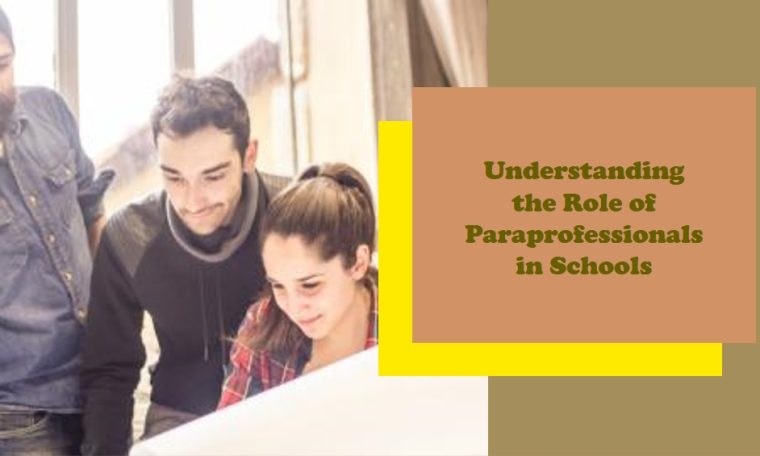
Most people would be in doubt about what is a paraprofessional in schools. A Paraprofessional is a person who guides the students under the assigned or licensed teacher. They have to provide the students with instructional and non-instructional support. This support would be helping the students to reach their potential. The duties of the paraprofessional teacher are to guide the students, keep records, and take a management session with the students. If the person wants to become a paraprofessional teacher then they have to read the below content.
What is paraprofessional?
For being a paraprofessional teacher, a person should have the ability to teach the students in bulk and provide attention to each and every student. The tasks that would be assigned to the paraprofessional teacher would depend upon the school and grade in which they would be sent.
Tasks performed by paraprofessional teachers are as follows:
- They have to work with the students and have to answer the questions in which they are having a doubt.
- The paraprofessional teacher has to provide administrative support.
- They have to maintain a positive behavior in the classroom.
- When the students are having recess time or are on a school trip, they have to take care of the students.
- Paraprofessional teachers have to provide the students with special education needs.
- They have to support the students.
Working to supervise students
You would know that schools are having the pressure of assigning new teachers for the school but there is a lot of shortage. The old teachers are provided with more responsibilities. This is where the paraprofessional teachers usually play an important role in the classrooms. These teachers are providing direct help to the certified teachers so that they can focus on the students and teach them new things. They are simply considered the backbone for certified teachers. You would be glad to know that they can be hired in either private schools or government schools. They can even work in children’s care centers.
Who are Paraprofessionals?
Simply defined, a paraprofessional – often called a paraeducator, parapro, or instructional aide – is an individual who works alongside and assists certified teachers. Their roles are to support students and staff through instructional and clerical assistance.
Paras do not need to possess an educator’s teaching certificate but must meet minimum qualifications set by their district or state. This may involve having an associate’s degree, some college credits, or passing a competency exam. Their purpose is to augment teachers’ efforts, not replace them.
Common Responsibilities
Here are some typical responsibilities paraprofessionals take on:
- Academic Support: Work directly with students providing one-on-one or small group instruction and assistance with subjects like reading, math, writing and more.
- Behavior Management: Help monitor and redirect student behavior following the teacher’s classroom management plan.
- Preparation Support: Assist in setting up materials and supplies for lessons, projects or activities. Provide support in grading, research and filing.
- Classroom Operations: Help manage day-to-day tasks like attendance, lunch counts or transitions between subjects/activities.
- Special Education Support: Commonly work hands-on with students who have learning disabilities, autism, developmental delays or other special needs.
- Clerical Duties: Handle organizational work like photocopying, record-keeping and communication materials.
The Scope of the Role
As you can see, paraprofessionals fulfill a wide range of academic and operational support responsibilities under the direction of their supervising teacher. Their job scope is flexible based on students’ needs and school demands.
Primarily they work in general or special education classrooms assisting certified instructors. Some may also be assigned to areas like computer labs, libraries or recess supervision. Paras can make a big difference in educational outcomes through their individualized attention and valuable behind-the-scenes contributions every day.
Six types of paraprofessional jobs
Different types of paraprofessional jobs are as follows:
- Special education support
- Instructional support
- Computer lab monitor
- Library aid
- Interpreter
- Teacher’s aid
- Playground monitor
The skills and responsibilities are different for each area. This depends upon where you are working. The main focus of the paraprofessional teacher is to provide help to the students, facilitate social interactions, and many more.
Additional Details About Paraprofessionals
Here are some additional details about the paraprofessional role:
- Education requirements can vary by state and district, but many only require a high school diploma or equivalent. Some locales are raising the minimum to an associate’s degree as the role expands in scope and importance.
- In addition to classroom support, paraprofessionals may accompany students to related services like occupational/physical therapy, speech language therapy, counseling sessions, etc. This helps promote continuity of instruction.
- Communication and collaboration skills are essential as paras must work as a team member with teachers, therapists, administrators and families. They serve as extra sets of eyes and ears to observe students.
- Professional development opportunities allow paras to continuously build their skills in behavior management, curriculum comprehension, child development best practices and more. This enhances their contributions.
- While the core responsibilities remain instructional and operational support, some districts leverage paraprofessionals’ expertise in certain roles like translating for ELL students, overseeing inclusion programs and assisting with extracurricular activities.
- Job satisfaction comes from encouraging independent problem-solving in students and witnessing their academic/social growth over time. Building trusting relationships is rewarding for paras.
- The role, while valuable, is often underpaid and under-recognize given paras’ direct hands-on impact. But their supplemental efforts are appreciat by teachers aiming to meet all students’ diverse needs.
Also Read: Finding Hope and Healing: Your Guide to IOP Programs Near You
Conclusion
To become a paraprofessional teacher, the person should have a proper certificate or qualification as mandated by their state. Often this requires a high school diploma or equivalent, with some colleges or training programs offering paraprofessional certificates and credentials. You would be glad to know that this is consider one of the best jobs in the education field for those interest in boosting student outcomes and making a difference, as the position of a paraprofessional is in great demand across most school districts and networks. To choose a good paraprofessional teacher, the administrators and supervising educators would pay close attention to the individual’s skills and strategies they employ to engage effectively with students, explain concepts, manage behaviors, and implement the teacher’s instructional plans such that every child is appropriately support and able to learn. Their rapport and rapport with both students and other staff would also be important factors consider during the selection process.



